Given the renewed interest in turntables, especially quality decks, I wanted to share some details about servicing the legendary Kenwood KD-600.
The Kenwood KD-600 / 650 is a classic direct drive turntable from the late ’70s. The KD-600 is a superb deck, for a number of technical reasons: 20 pole, 30 slot brushless motor, synthetic concrete-composite chassis, 3 kg platter, massive main bearing assembly and so on.
Need for Service
One way to tell the bearing needs service is if you’ve noticed a gradual increase in rumble, or if you can feel any wobble in the platter if you GENTLY press on either side of it. The bearing tolerances in this deck are such that you should feel no wobble with a properly maintained bearing.
Here are a few images of the process on my own Kenwood KD-600 with custom armboard and Jelco SA-750D tonearm.


Bearing Access
The KD-600 bearing assembly is serviceable from above or below. The bottom of the bearing assembly features a metal bearing cap and rubber sealing gasket held on by three small screws. This can be removed and oil added to the reservoir section of the bearing.
However, this is not the ideal method. Instead, I prefer to remove the platter, motor top-plate and rotor, with integral spindle bearing shaft. This exposes the whole of the inner bearing well, which is cleaned before adding a few drops of quality synthetic bearing oil to the bearing.
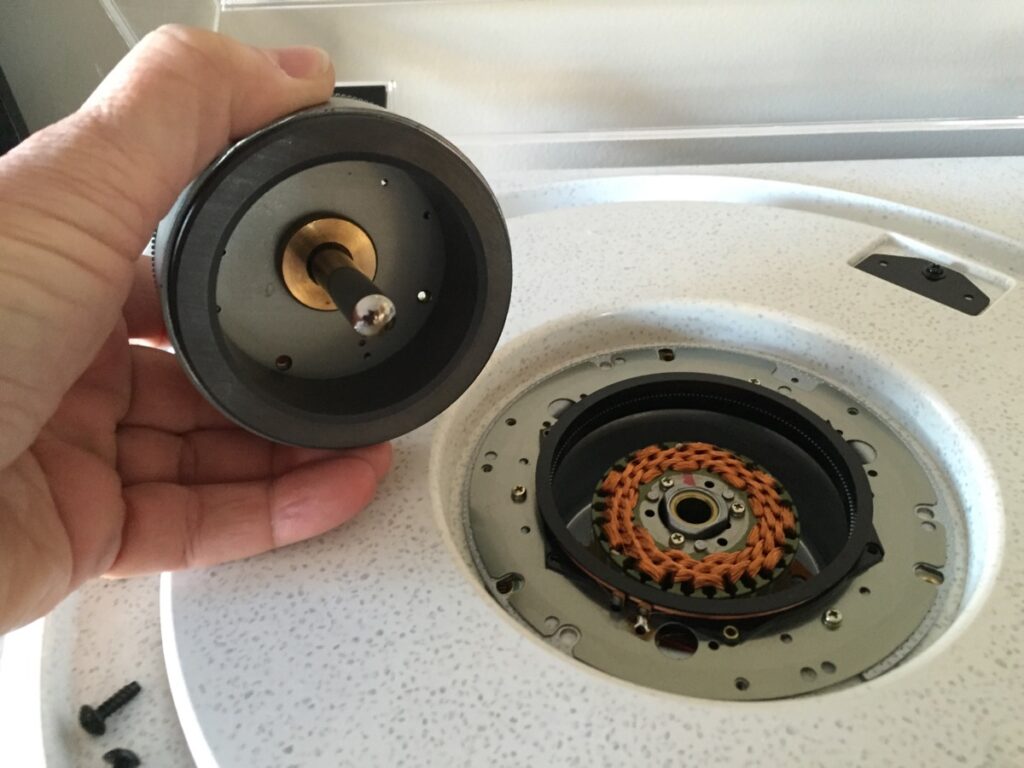

Bearing Service
You want to be sure to use lint-free cleaning materials so as not to leave any fibres in the bearing that could become caught between the well and shaft. It’s also extremely important not to overfill the bearing – I use an oiler stick which allows me to deposit the correct number of drops of oil in the bearing. NEVER just pour oil straight in as you will overfill it and oil will spill out into other parts of the motor.


Reassembly
Once you have the correct amount of oil in the clean bearing, it’s time to reinstall the rotor into the motor. As I mentioned, these are tight-tolerance motors. On my deck, it takes several hours for the rotor to displace air inside the bearing and drop into place.
Never force this part of the process, just allow it to settle back down naturally into place. You can spin the spindle in your fingers, by all means, just don’t press down on the rotor – we don’t want to create a high-pressure situation inside the bearing.

Discover more from LiQUiD AUDiO
Subscribe to get the latest posts sent to your email.

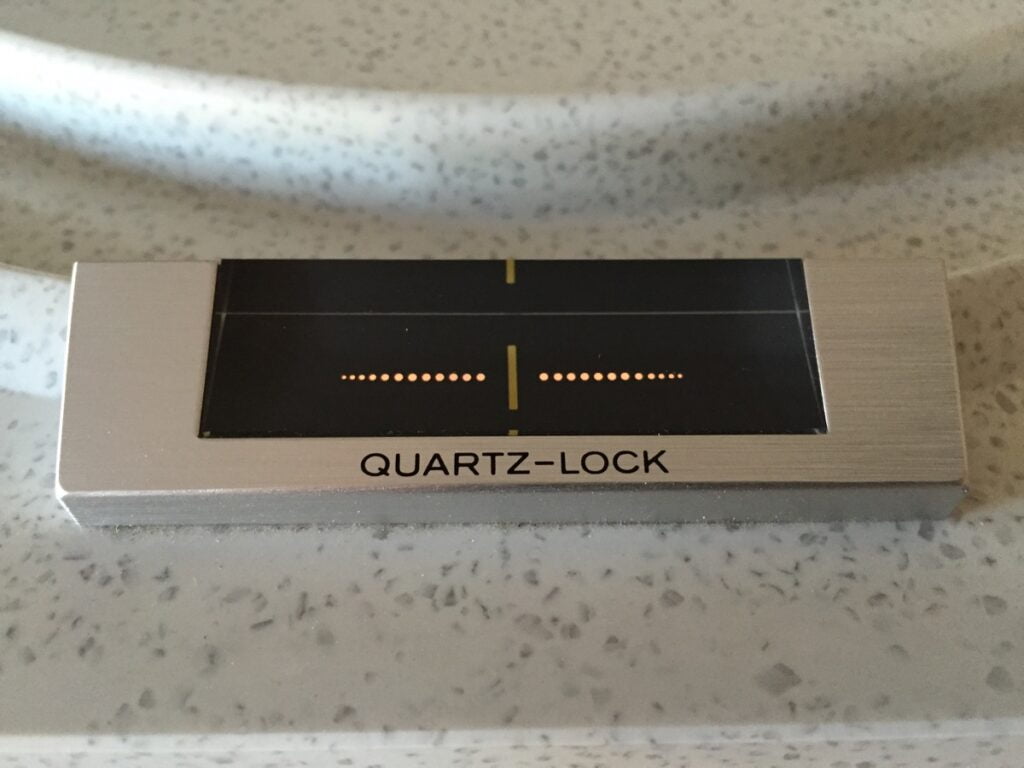

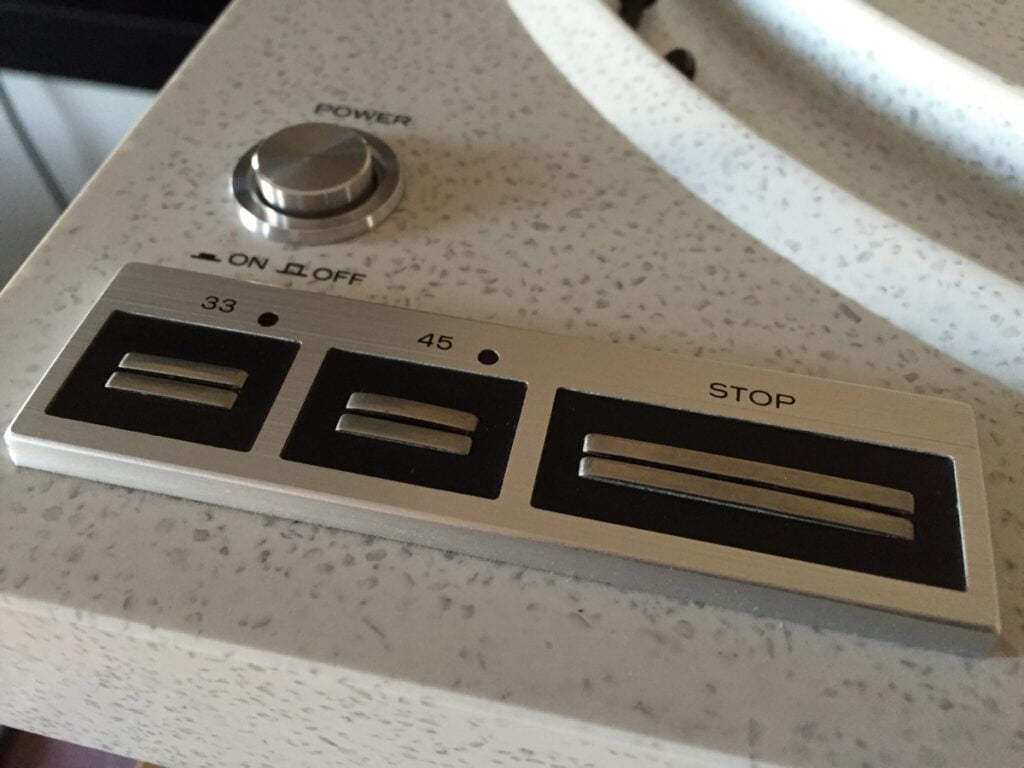
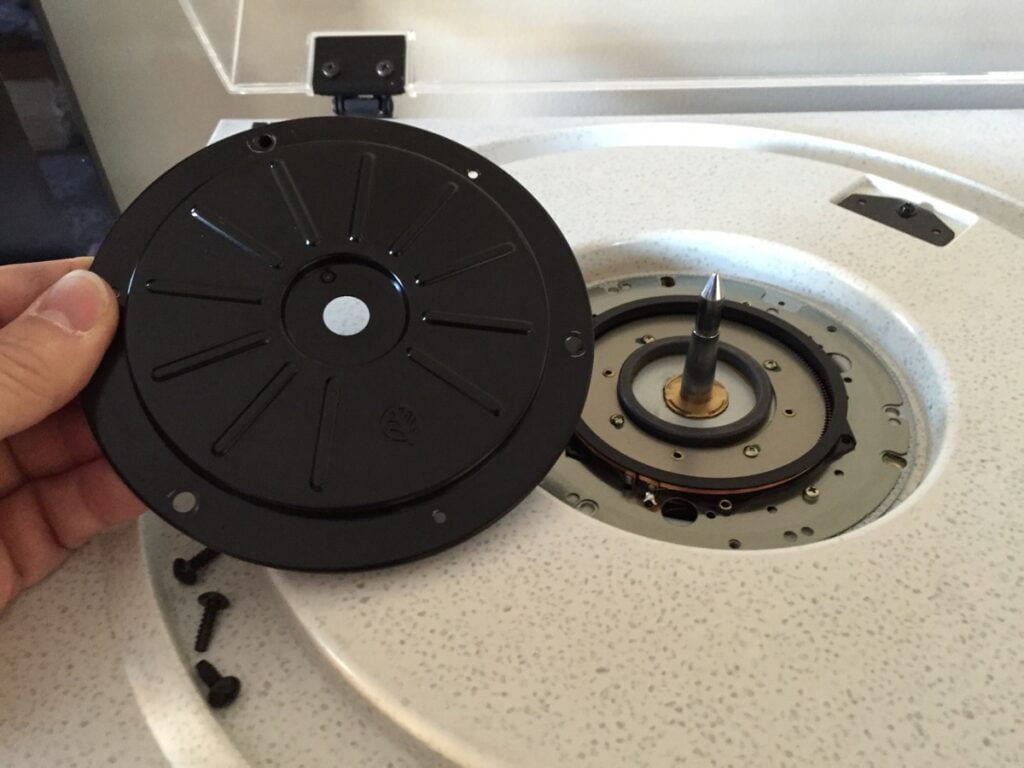
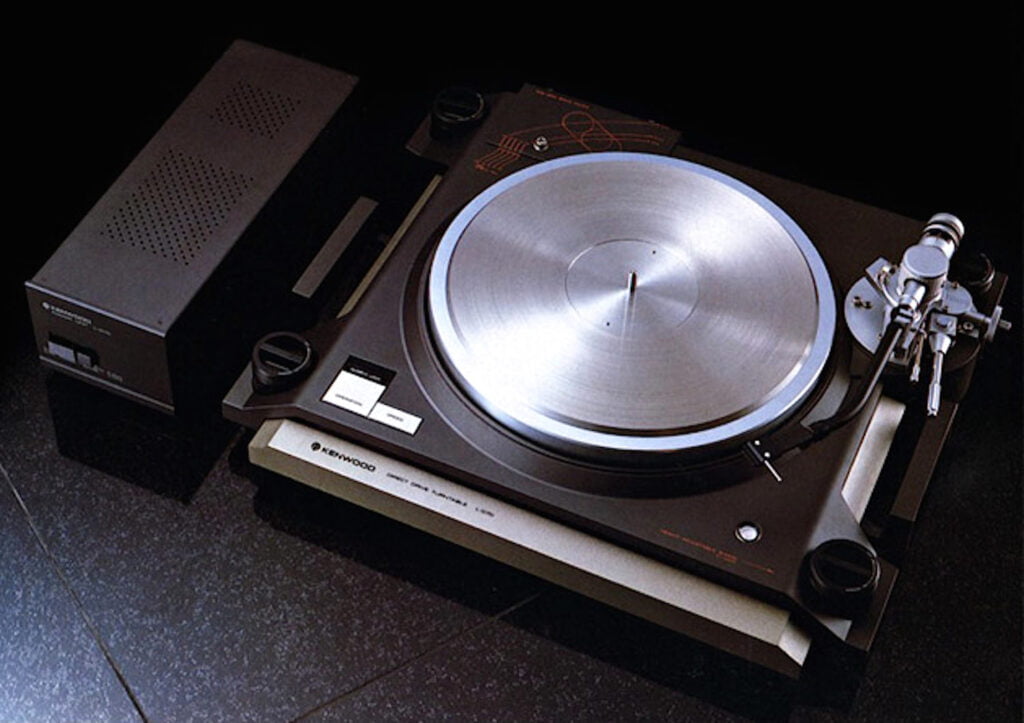
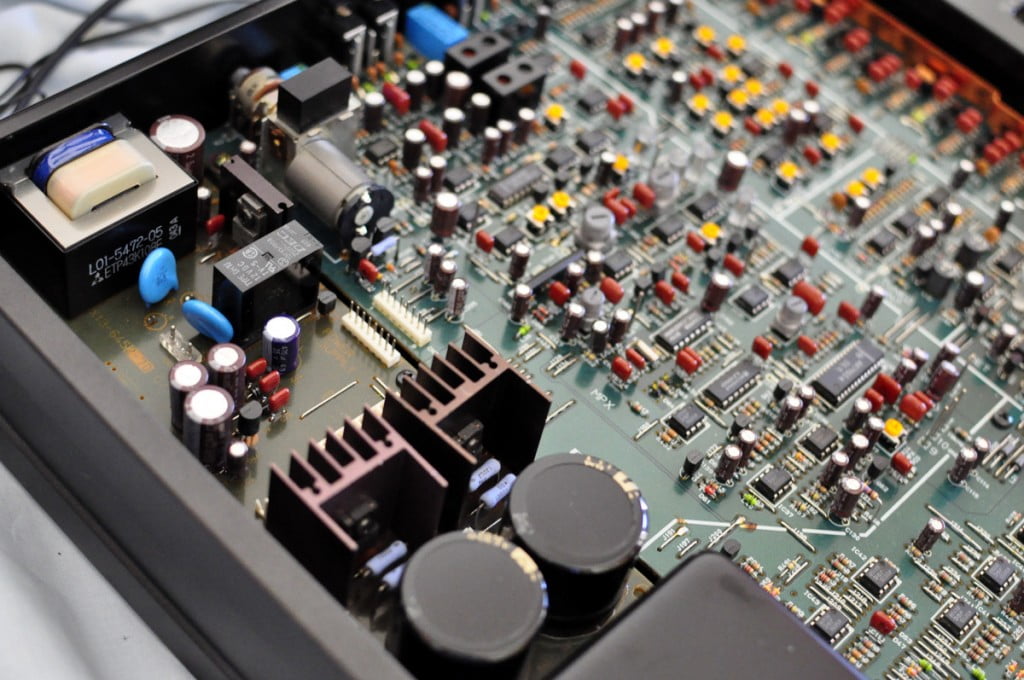
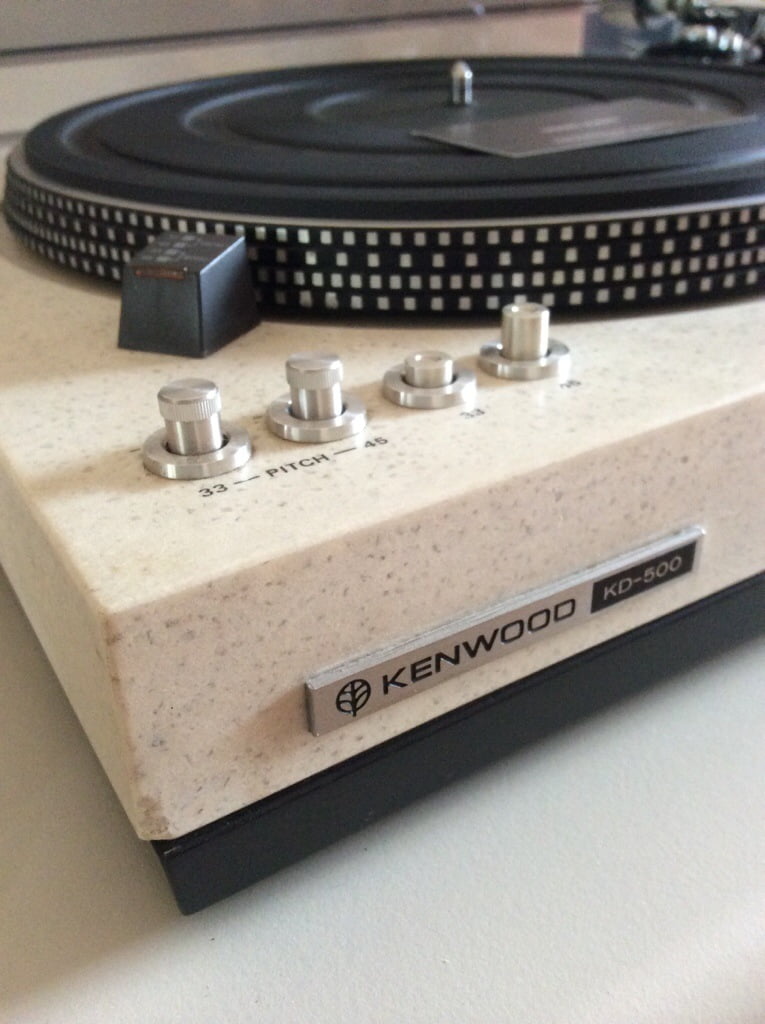
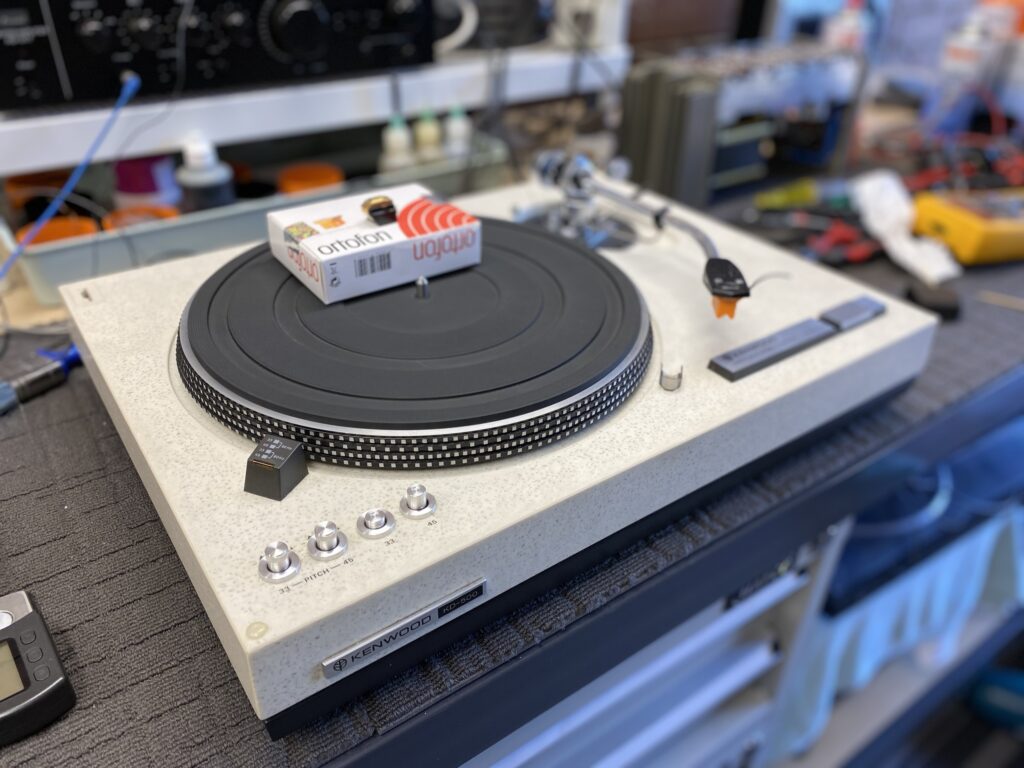
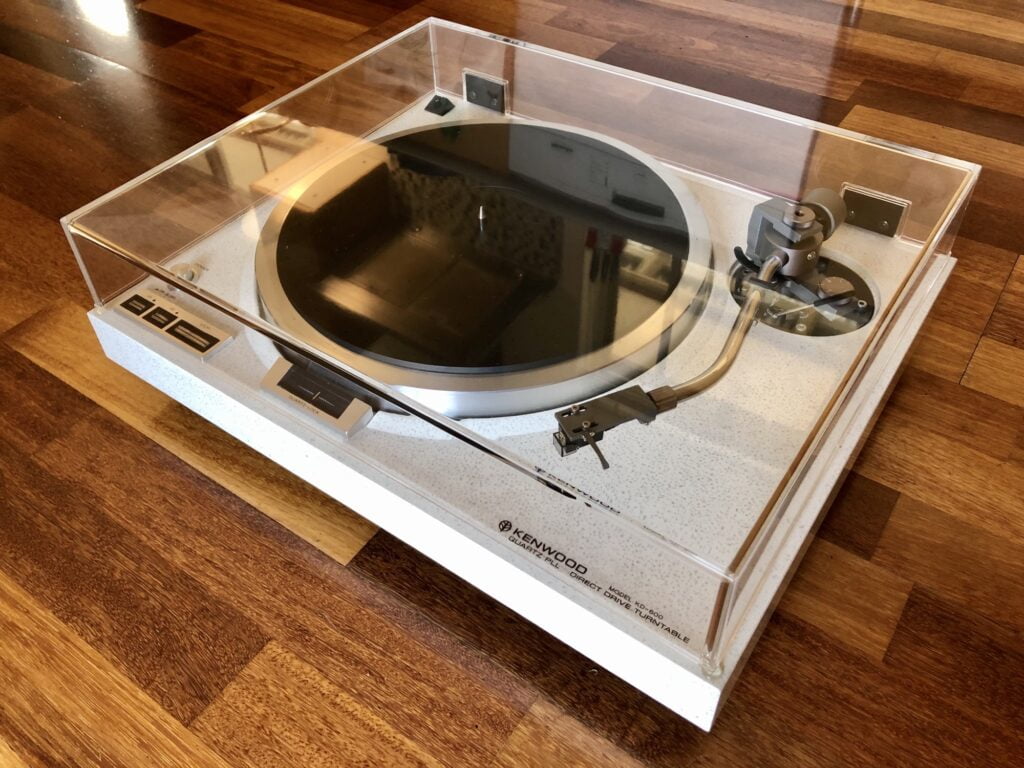
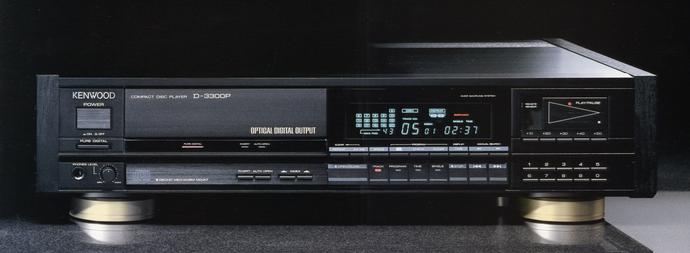
So we clean out inside that hole? What do you clean it with and do you use oil or grease? How much oil or grease goes in there?
Hi Peter, yes the bearing well must be very carefully cleaned with an absorbent, lint-free material. A tiny amount of synthetic bearing oil, not grease, should then be carefully applied. The exact amount is difficult to measure, but just enough to barely cover the base of the bearing well. I don’t recommend doing this unless you have the correct oil, the right tools for the job and experience, as it is easy to damage something and this would be very bad news.
Hi Mike,
I have a Trio KP-7700 (Kenwood KD-750) that appears to use the same drive. I noticed an audible sound whenever the drive engaged, and following your post found there was some play in the bearing. I cleaned and oiled the bearing, and there now appears to be no play (I assume the oil is dampening things) however it only took a few minutes for the shaft to settle to the bottom, and the noise is still present. I’m a bit worried the bearing has worn out.
Even though this post is ancient I thought I’d ask if you had a hunch about what might be wrong. I live in a place that is decidedly low on vintage Kenwood experts :p
Cheers!
Hi Darren, thanks for your email. It does indeed sound like there is some bearing wear there. The best option is to re-clean the bearing and use a slightly thicker grade of synthetic oil – perhaps a 30 – 50W grade. Also, you must use a completely lint and dust-free cleaning implement, otherwise micro-fibres will be trapped in the bearing, adding to the problems. Check that you have added enough oil to the bearing and that it does not leak from the bearing cap at the base of the bearing. The spindle/rotor assembly should then take some time to settle back into the bearing. My post isn’t that ancient BTW, but I definitely need to write some new articles! I have new motor service articles in the pipeline! Cheers, Mike.
Hi Mike,
Thanks for taking the time to respond.
You inspired me and I decided to remove the motor and clean it thoroughly from both ends. I have to get some heavier oil tomorrow, so I’m not sure that the issue is solved, but I uncovered a few things. Simplest, the Teflon thrust pad has an indent from the bearing. Not sure if that’s proper. Thought I might flip it over if nothing else works.
Also, one of the capacitors had pushed through the board and severed the printed circuit. Strangely the deck still ran even with this problem. A little solder and a bridge wire later, it’s operation seems consistent. Quite strange!
I checked the motor with a stethoscope and there is definitely a clicking or knocking sound anytime the coils energize. I hope the heavier oil will do the trick though, it’d be a shame for this deck to be unrepairable!
Hi Darren, the indentation in the Teflon thrust bearing is normal and why it is important to replace that bearing cap in the exact same orientation it was originally. I would not recommend reversing the thrust pad, nothing good can come of damaging the delicate thrust bearing! Motor operation should be silent, so something else is going one here. Stethoscope was a good idea, see it the noise changes under load and if there is any wobble in the platter-spindle interface, vs the bearing itself.
Well Mike, I am vexed! Re-lubed, still noisy. Removed the motor and dismantled it down to the coil and bearing/spindle, still making noise. Silent when spun by hand, but every time it cocks there’s that sound. When holding the stripped-down drive in my hand, free of it’s speed-check mechanism, I noticed that it “clicks” in position at each stator. This seems to be the origin of the sound. YouTube link for posterity:
https://youtu.be/I9Z1vYvRDv8
Bearing settles a bit slower with the W50 but still over the course of minutes, not hours. Checked by hand and the play in the bearing seems to have lessened after lubing, but perhaps the electromag puts a strong enough pull on the rotor to displace the lube? Maybe some light grease would help instead of thicK oil?
There’s definitely some abrasion inside the top 1/3rd of the bearing well. If only it were an electrical problem!
And too bad you’re on the other side of the globe! I’m grateful for your time, and equally so for your rad blog! If you have any other ideas I’m all eyes. (Or if you have a spare motor I’m all PayPal ;D)
Ive had a look at the video – its important to remember that running the DD motor without spindle is like running an engine without as flywheel – they are integral and will behave strangely without the associated inertia of the flywheel in both cases. The unloaded turntable motor will not be able to sustain constant rotation and the control circuitry will throw large currents into the windings in an attempt to sustain constant rotation – this could result in the clicking! My question is – what does she do with the platter on when run in the normal configuration? Is there any clicking when set to play a record?
Well Mike, I am vexed! Re-lubed, still noisy. Removed the motor and dismantled it down to the coil and bearing/spindle, still making noise. Silent when spun by hand, but every time it cocks there’s that sound. When holding the stripped-down drive in my hand, free of it’s speed-check mechanism, I noticed that it “clicks” in position at each stator. This seems to be the origin of the sound. YouTube link for posterity:
youtu.be/I9Z1vYvRDv8
Bearing settles a bit slower with the W50 but still over the course of minutes, not hours. Checked by hand and the play in the bearing seems to have lessened after lubing, but perhaps the electromag puts a strong enough pull on the rotor to displace the lube? Maybe some light grease would help instead of thicK oil?
There’s definitely some abrasion inside the top 1/3rd of the bearing well. If only it were an electrical problem!
And too bad you’re on the other side of the globe! I’m grateful for your time, and equally so for your rad blog! If you have any other ideas I’m all eyes.
Well Mike, I am vexed! Re-lubed, still noisy. Removed the motor and dismantled it down to the coil and bearing/spindle, still making noise. Silent when spun by hand, but every time it cocks there’s that sound. When holding the stripped-down drive in my hand, free of it’s speed-check mechanism, I noticed that it “clicks” in position at each stator. This seems to be the origin of the sound.
Bearing settles a bit slower with the W50 but still over the course of minutes, not hours. Checked by hand and the play in the bearing seems to have lessened after lubing, but perhaps the electromag puts a strong enough pull on the rotor to displace the lube? Maybe some light grease would help instead of thicK oil?
There’s definitely some abrasion inside the top 1/3rd of the bearing well. If only it were an electrical problem!
And too bad you’re on the other side of the globe! I’m grateful for your time, and equally so for your rad blog! If you have any other ideas I’m all eyes.
Hi Darren, vexing indeed, though the bearing is definitely not meant to hold grease and if grease seems like the solution, there is something wrong with the clearance in the bearing. This may be tied into the clicking you are hearing, I will watch the video and see if it gives me any more clues. All I can think is that something is out of specified clearance and rubbing or touching. Are there any other clues..?!
Hey Mike,
I extracted the bearing and coil assembly and with the spindle properly seated I checked to make sure there was no contact beyond the shaft in the well. There seemed to be enough clearance for the coils and the circuit board. Holding the assembly by the base of the bearing well, I let the drive spin under power. At this point it was free of the housing and speed-check mechanism as well.
It vibrates and jitters and holding the spindle I could feel it “snap” into place at each stator. This is what it seems to be doing when mounted in its housing as well, as the entire drive base wants to counter-rotate whenever the spindle assembly cocks to keep the drive spinning.
There are definitely some wear marks inside the bearing well, and as I mentioned the bearing doesn’t seem to have quite as tight a fit as you might expect.
Thanks for looking at the video. If you look at my channel there should be one more video with the platter on. Same clicking sound.
Is there any possibility this is an electrical issue? It still has its original caps, could the coils perhaps be engaging too strongly?
Hi Darren, I must reiterate that you should not expect the motor to behave normally when energized with no platter attached, as I mentioned before. The drive system relies on mechanical inertia as a mathematical value in the speed control equation. What we need to clarify is the cause of any clicking with the platter attached. That is strange and could indicate an electronic control fault. Its best not to just throw caps at this, adjusting the drive and braking parameters should be done first, but you need good equipment to do this – do you have a good dual trace oscilloscope with probes and multi-meter for adjusting motor drive? Do you have the service manual? This is the best starting point, check this stuff and then proceed with repairs as required in my opinion.
Hi Mike,
I do have an older oscilloscope and a good multimeter, as well as a laser tachometer. Interestingly, the speed is mostly bang-on (although 33 loses Quartz lock intermittently).
I have read the service manual (via vinyl engine). You’re suggesting I adjust VR1 and VR2 potentiometers then?
I’m aware that without the platter the drive will act strangely, I should have linked the proper video first, my apologies 😛
I’m gaining hope now that this is an electrical issue. If only!
You need to very carefully follow the service procedure – this is tricky, so be very careful. It should lock perfectly, if she’s not, there is an electrical problem. You need to get both waveforms simultaneously displayed on your scope, hence two probes are required. This is a pain, so get set up and go slowly. Be aware that you can kill the deck at this point by just making a small mistake, and yourself if you are not careful!
So if I’m understanding you correctly, I should adjust VR1 and VR2 which control the RPMs at which the table Quartz locks?
Seems like a delicate job, to be sure. I assume oscilloscope is preferred to tracking the platter with a tachometer?
The player runs stable at 45rpm as is, the trouble is that the motor noise is stil present. As mentioned, 33 drops out here and there.
I’ll give it a shot and pray that the noise clears up. If it doesn’t, perhaps the coils are receiving to much current?
You are a rock star, by the way!
The coils cant receive too much current, this is not how electricity flows in a circuit. They could not generally draw too much current, instead they would fail open and draw no current. Don’t use tacho, you need to follow the service manual precisely and use a good scope. If unsure of how to do this, definitely don’t mess with it. This is normally only something you should do if you are very familiar with using test and measurement equipment to calibrate electronics. From memory there are four pots, not just two. All need to be adjusted exactly as described. I can’t do much more without having the deck in front of me, so be careful. As I said, you can easily make things worse or kill the deck if this is not something you regularly do!
Thanks for everything, Mike!
I’ll do a little more research. The procedure in the KD-750 manual is actually pretty straight forward (if requiring a steady hand). The procedure is only speaking of two potentiometers, but I’ll make sure not to dive in unless I’m fully confident.
Keep up the awesome blog! And sincerely, thanks for taking the time to help a stranger on the other side of the globe!
Thanks Darren and it’s a pleasure! I thought you had a KD-600/650, but the motor is the same I think. Maybe they simplified the circuitry in the 750, the 600/650 have four pots for sure. Let me know how you get on with this.
Well, Mike!
I’ve now witnessed that the noise occurs simultaneously to when the Quartz lock light flickers off, which leads me to believe it’s the table kicking the motor into motion to try and hold the lock.
45rpm holds fine, and there’s not really any clicking. Unless the Quartz lock drops out for half a second.
33rpm does not hold, and I’m finding it impossible to find a position on the trim pot where the Quartz lock stays engaged. The RPMs are definitely fluctuating, which shouldn’t happen because the trim pots should control absolute speed (this is where the 750 differs from the 600 I believe, as the values for the Quartz lock are set.. somewhere.. by something.)
So:
Bearing friction slowing things down unexpectedly, throwing off the lock?
Did I not get enough contact cleaner into the trim pot and all my frustration boils down to some oxidation?
Is the trim pot fine, and it’s another part of the circuit that’s malfunctioning?
Still a mystery!
Hi Darren, yes it sounds like the phase locked loop (PLL) control circuitry energising the coils to try to maintain lock, which is actually what I was suggesting might be the issue, hence the need to carefully adjust as per the service manual. Quartz lock should not drop out, ever. If it does, the control circuit is not working correctly. If it is not working correctly there are three possible causes, in order of likelihood: misadjustment of control circuit, worn or damaged electronic component eg caps or hall-effect sensors, wear or damaged hardware ie motor.
Hey Mike,
Thought I’d drop you a update. Through some weird coincidence I recently had a skilled tech move right down the street from me, and I discovered him shortly thereafter. He was able to diagnose and repair the electrical issues and the table locks fine now (Kenwood 750/Trio 7700). There is still a faint “clicking” or “ticking” sound, which can be heard if you put your ear up to the platter, and I’m thinking it’s probably an unresolveable issue linked to the slightly sloppy bearing. It doesn’t make itself apparent through the cartridge so I’m thinking the best solution is to ignore it ;P
Thanks again for all your previous guidance! I also enjoyed your blog on the Denon 1200 as I have that deck as well.
Cheers!
Hey Darren, really glad to hear that things are resolved or nearly so! I still don’t think it is a bearing as bearings don’t make this sound. For me it’s more likely to be electrical, but either way, good news that she is running nicely. Also glad you liked the DP-1200 piece, Ive worked on quite a few of these great old decks. I’ll be adding more new articles soon! Cheers, Mike
So, I added 3 more drops of oil annnnd … the bearing still settles quickly But, the quartz speed lock now works all the time! Before it was hit & miss depending (I think) on what the temperature was. Thanks for all the wonderful advice Mike!!
Hi Tim, thanks for the update and my apologies, due to a site technical issue, your previous comment may have been lost. I recently lost about 10 days worth of comments and content, very annoying!
On to the Kenwood, good work adding extra oil. I’m wondering if you are adding it so that it coats the side walls of the bearing well? I always do this, so that the oil evenly coats the inside of the bearing, it’s something I’ve discovered is helpful over many services. The rotor assembly definitely shouldn’t drop that quickly, something is not quite right there. Anyway, very glad the quartz lock is working better for you. The lock is adjustable and really this is best way to ensure correct operation. You need a dual channel scope and probes though, plus some experience to do that part and a jig to hold the turntable up off your work surface. Its a real pain to be honest, but worth doing along with speed adjustment!
It just so happens that I am having this exact same ticking motor issue, on 2 turntables, nonetheless. One is a Kenwood KD-750 120v North American model, which has been recapped. The other is the Japanese 100v variant of the KD-750, the Trio KP-7700, which is stock, to my knowledge.
Both of them lock onto speed and hold it properly. The thing is that both of them present this ticking noise while the motor is spinning and the quartz lock has locked. It is definitely an electrical noise that seems to be associate with quartz lock, and not a bearing issue. The noise does not present itself while the platter is spinning up but has not yet locked onto speed, or while turning the platter by hand. There is also an audible ‘click’ during the motor braking, after pressing ‘stop’ or going from 45 to 33 rpm. This is a louder version of the same ticking noise, that only happens once.
I just got the KD-750 back from a reputable local tech who said that he didn’t hear the noise at all, but it is still there, as I expected. I understand that it is pretty faint, and I can be anal in regards to things like this, but the main reason that I like DD turntables so much is that they are supposed to be completely silent. He said that all the internal measurements were spot-on. I just wish I could get to the bottom of this. This couldn’t simply be an effect of how the motor circuit works normally, could it?
Thank you!
Ben
Hi Ben, no I’ve worked on dozens of these and they are completely silent when working correctly. This is of course assuming you have earthed the chassis and tonearm correctly also. System variables can play a big part in getting a turntable to run quietly.
Hi Mike,
I really appreciate the quick reply. That’s what I figured. Granted, the noise is faint, and probably not something you would hear unless you were specifically listening for noise from the motor, but it is there. The previous owner of the KD-750 didn’t notice it either. It’s too bad I’m not in Perth, as I’m sure you’d be able to get to the bottom of it. You don’t happen to know of any good techs familiar with this model in Southern California, do you?
Thanks again for your help,
Ben
Hi Ben, no worries and sorry but I don’t know anyone there I could recommend. Be sure to also check the deck in a different system to make sure the noise doesn’t relate to your equipment and set-up.
No problem, thanks for the help! I want to clean out the bearing well and re-oil it, as I’m sure it needs it at this point (I’m familiar with the precautions required to do this). What type of oil do you use? I’ve read conflicting things online, as some people say it uses grease, while others say it uses oil.
Thanks again,
Ben
Hi Ben and yes you’ll read all sorts of nonsense in forums and elsewhere. This is an oil-bearing and I suggest a small amount of medium-weight, ie around 30W synthetic machine or bearing oil. Kenwood used mineral oil and this is also acceptable. This particular bearing is not a grease bearing, some turntables do use grease, definitely not this one!
Thank you again Mike, I really appreciate it! I didn’t think it used grease, but I just wanted to make sure. There certainly is an unfortunate amount of misinformation out there regarding audio equipment.
Hi Ben, no problem at all and it sounds like you are definitely on the right track!